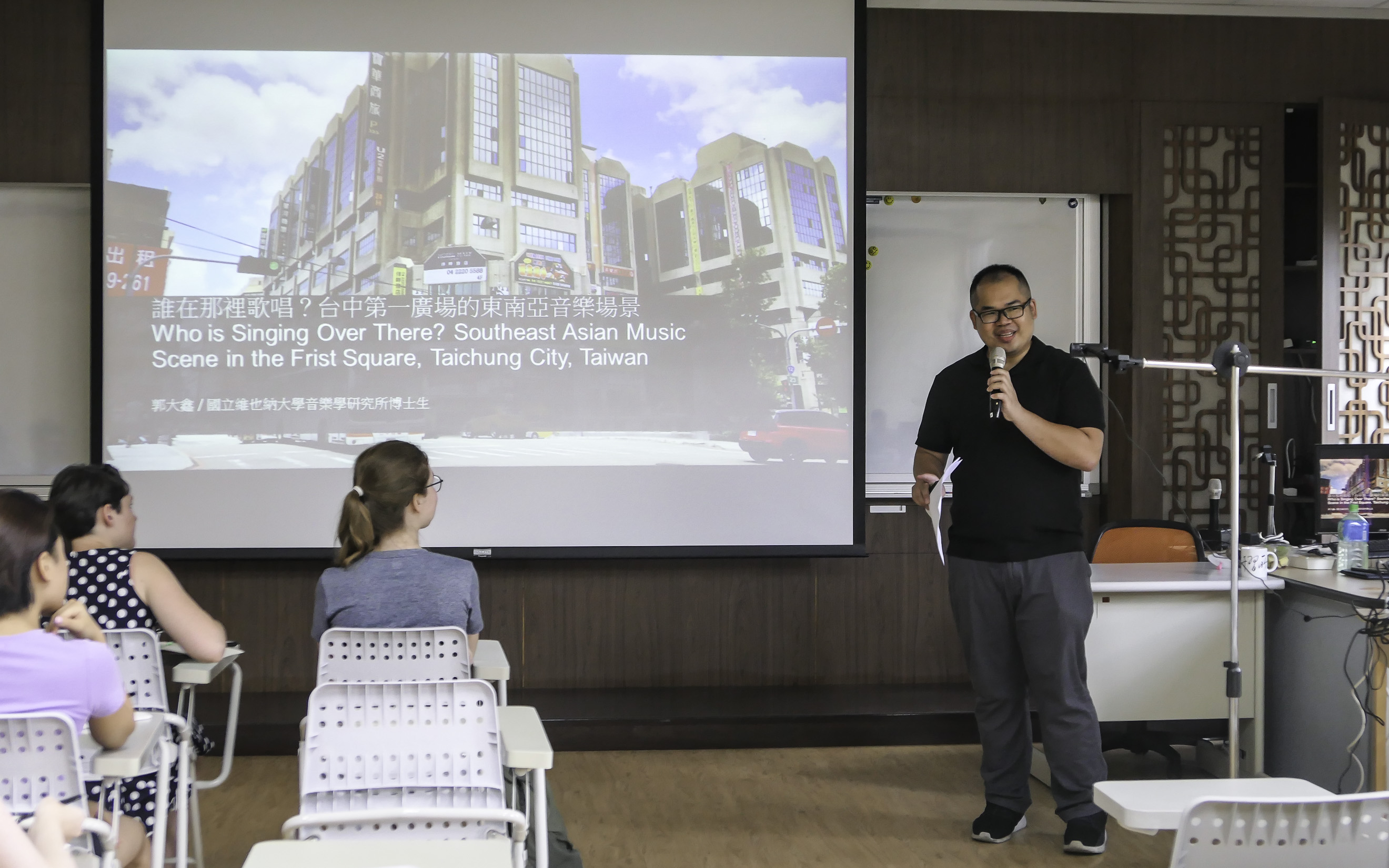
(English below)
離臺中火車站僅幾步之遙,就是一座不起眼的13層大樓。裡面的商店就像一般的臺式傳統市場一樣堆滿了衣服、食物、雜物。然而,此一市場卻有些與眾不同:招牌是用越南語寫的,零食是從菲律賓來的品牌,而且泰式餐廳密度異常地高。人們共聚一堂,唱著dangdut卡拉OK或是聽著來自菲律賓的搖滾樂團演出。
正是由於此活躍的氣氛,民族音樂學家郭大鑫來到了家鄉臺中的第一廣場,以研究其豐富多彩的東南亞音樂文化。郭先生於今年6月19日與ICLP師生慷慨地分享他的研究成果,以及研究過程中的一些故事。
建於日治時代的第一廣場,曾經是普通的傳統市場,直到1995年遭到了一場火災,並引發了一些迷信傳說,因而改變了其發展進程。
「由於火災,臺灣人突然不敢去第一廣場,因為有謠言說幽靈船漂浮在樓頂上,會奪走更多人命,」郭先生說道。過了不久,來自東南亞的新住民逐漸搬過來開店。「外籍勞工來到這裡。新住民的姊妹們,他們在這裡開餐廳服務這些外籍勞工,然後這裡就越來越熱鬧了。」
久而久之,第一廣場成為臺中及全臺新住民重要的社交場所。政策上也反映了其變化:市政府於2015年決定將第一廣場改建為較為時尚的商場,改稱為「東協廣場」。
郭先生回到臺中之後,很想念在歐洲學習期間經常造訪的舞廳,因此,第一廣場六樓的舞廳成為他融入其東南亞社區的起點。每個客人在走出舞廳樓層的電梯時,就會立即看到兩個招牌,分別指向屬於不同國家的兩個方向。郭先生說,他因有著與來自東南亞的新住民相似的外貌而成為格外容易被接受的「外來者」,如此具有組織性的娛樂場所就是為了「有一個空間讓他們(新住民)可以很舒服地成為他們原本的樣子。」
有一次,郭先生跟一位按了13樓的客人一起上電梯,當被問到頂層有什麼東西的時候,客人就回答「耶穌」。自從那時起,郭先生多次在週日去第一廣場頂層的菲律賓教堂做禮拜。「他們希望每個人可以參加,所以即使想唱他加祿語的歌,也還會唱一些大家都知道的英語歌。他們刻意這麼做,以便讓每位來賓都能玩得開心,」他說。
「任何的方式其實都是在幫助大家更多的連結。一開始的出發點就是大家都想在一起。」郭先生解釋。無論是客廳裡的卡拉OK、印尼的qasidah、或菲律賓的傳統kulintang,各種音樂的共同點就是社區精神。
儘管第一廣場受到臺中市政府的重視,但聚集在裡面的人卻尚未獲得相同的尊重。舉例來說,市政府為了慶祝綠川改造計畫成功,策劃了《川游不息─綠川展2018》,邀請藝術家參與展覽,並藉著展覽表達這塊土地「屬於臺中人」。但是郭先生指出,「我不知東南亞人是否有機會被寫入臺中歷史中。我們必須挑戰這種認為臺中只屬於臺中人的概念。」
此外,儘管市政府針對新住民策劃了不少活動,然而這些活動並不真的促進了臺灣人與新住民之間的交流。郭先生反而認為應該辦活動給臺灣人來了解東南亞文化,因為「讓他們先感興趣,之後才有更多交流的空間。」
總之不管有沒有活動、有何活動,第一廣場每天都提供機會給所有訪客來認識這個臺灣社會不可或缺的群體。如果想去的話,郭先生建議先聯絡1095文史工作室,一個致力於改善新住民在臺環境的團體。
「臺灣是個美麗島,有各種各樣的民族與文化,但是還有許多未知的故事,我們必須聽到。」郭先生說,並鼓勵ICLP學生下次在臺中旅遊時,不妨去逛逛第一廣場。

Just steps northwest of Taichung Station is an unassuming 13-story complex, the shops crammed with clothing, food, and trinkets like any other traditional Taiwanese market. Yet this market isn’t like any other. There are signs in Vietnamese, Philippine snack brands, and an unusually high density of Thai restaurants. People gather to sing dangdut karaoke, or sometimes to hear a Philippine rock band.
It was this lively atmosphere that drew ethnomusicologist Kuo Ta-hsin to First Square in his hometown of Taichung to study its richly diverse Southeast Asian music scene. Kuo on June 19 generously shared his knowledge about this unconventional cultural center with ICLP, in addition to a few stories of his own.
As its construction suggests, First Square used to be a Taiwanese-style traditional market until a fire in 1995 engendered a superstition that changed the course of its history.
“Because of the fire, suddenly Taiwanese were afraid of going because there was a rumor about a ghost ship floating on top that would take more people’s lives,” Kuo said. But gradually, migrants from Southeast Asia began filling the dormant shops. “Foreign workers came here. Migrant women opened restaurants to cater to them, and this place became more and more lively.”
The square became an important social space for Southeast Asian residents of Taichung and around Taiwan, with the shift reflected in the city government’s decision in 2015 to turn the complex into a “fashionable” shopping mall renamed ASEAN Square.
For Kuo, who missed the dance halls he frequented while studying in Europe, the sixth floor provided both an escape and entry into the First Square community. Just outside the elevator, signs point visitors in two directions: one for a Vietnamese dance hall and the other for Philippine and Indonesian. Acceptance into these spaces hinged on Kuo’s appearance, as he could acceptably pass as Thai, Filipino, or Indonesian, but not Vietnamese. “It’s a space where they can be comfortable and act like themselves,” he said.
One time, he got into the elevator with a visitor who pushed the button for the top floor. When asked what was up there, the visitor said: “Jesus.” Most Sundays since, Kuo has attended services at the Philippine church. “They want everyone to join, so even if they want to sing Tagalog, they will try to use some English songs that everyone will know. They will do this on purpose so everyone can have fun,” he said.
“Every form [of music] actually helps people better connect with each other. The starting point is that everyone wants to be together,” Kuo said. Whether it is karaoke in a restaurant, Islamic qasidah, or kulintang music, community is the common thread that links them together.
Yet despite the recognition First Square earns in Taichung, there is still work to be done before the communities that gather inside gain equal acceptance. For example, to celebrate the renovation of the canal in front of the square, the city held an EDM festival to show that “this area belongs to the Taichung people,” but as Kuo pointed out: “I wonder if there is any opportunity in the future for those from Southeast Asia to be written in the history of Taichung. We need to challenge this thinking, that this place only belongs to the Taichung people.”
In addition, while the city organizes many Southeast Asian-themed events, they don’t seem to facilitate communication between Taiwanese and migrants. On the contrary, Kuo believes that there should be more events about Southeast Asian culture geared toward Taiwanese, because “once they become interested, then there will be more space for communication.”
With or without events to attend, First Square offers a daily opportunity to get to know this integral part of the Taiwanese community. Recognizing that it takes bravery to go somewhere new, Kuo recommends contacting the organization 1095, which serves to connect Southeast Asian migrants with others in Taiwan.
“Taiwan is a beautiful island, there are so many different people here who share their culture, but there are many uncovered stories we need to know,” Kuo said, encouraging ICLP students to visit First Square on their next visit to Taichung.

© ICLP-NTU. ALL RIGHTS RESERVED.